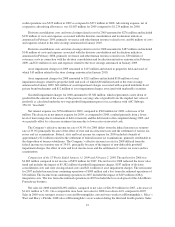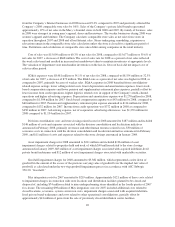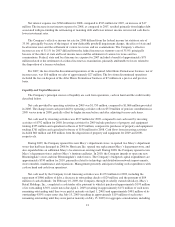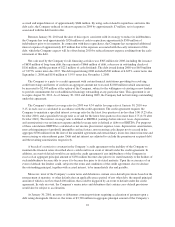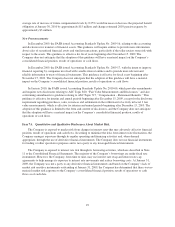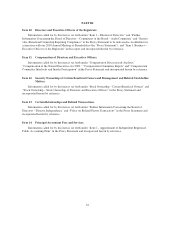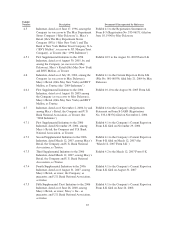Macy's 2009 Annual Report Download - page 34
Download and view the complete annual report
Please find page 34 of the 2009 Macy's annual report below. You can navigate through the pages in the report by either clicking on the pages listed below, or by using the keyword search tool below to find specific information within the annual report.The Pension Protection Act of 2006 provides the funding requirements for the Pension Plan which are
different than the employer’s accounting for the plan as outlined in ASC Topic 715. During 2009, the Company
made funding contributions to the Pension Plan totaling approximately $370 million. On February 22, 2010, the
Company made a funding contribution to the Pension Plan of $325 million. The Company does not presently
anticipate making any additional funding contributions to the Pension Plan during 2010, but may choose to do so
in its discretion. Management believes that, with respect to the Company’s current operations, cash on hand and
funds from operations, together with available borrowing under its credit facility and other capital resources, will
be sufficient to cover the Company’s Pension Plan cash requirements in both the near term and also over the
longer term.
At January 30, 2010, the Company had unrecognized actuarial losses of $1,186 million for the Pension Plan
and $94 million for the SERP. The unrecognized losses for the Pension Plan and the SERP will be recognized as
a component of pension expense in future years in accordance with ASC Topic 715, and is expected to impact
2010 Pension and SERP expense by approximately $64 million.
The calculation of pension expense and pension liabilities requires the use of a number of assumptions.
Changes in these assumptions can result in different expense and liability amounts, and future actual experience
may differ significantly from current expectations. The Company believes that the most critical assumptions
relate to the long-term rate of return on plan assets (in the case of the Pension Plan), the discount rate used to
determine the present value of projected benefit obligations and the weighted average rate of increase of future
compensation levels.
The Company has assumed that the Pension Plan’s assets will generate an annual long-term rate of return of
8.75%. The Company develops its expected long-term rate of return assumption by evaluating input from several
professional advisors taking into account the asset allocation of the portfolio and long-term asset class return
expectations, as well as long-term inflation assumptions. Pension expense increases or decreases as the expected
rate of return on the assets of the Pension Plan decreases or increases, respectively. Lowering the expected long-
term rate of return on the Pension Plan’s assets by 0.25% (from 8.75% to 8.50%) would increase the estimated
2010 pension expense by approximately $6 million and raising the expected long-term rate of return on the
Pension Plan’s assets by 0.25% (from 8.75% to 9.00%) would decrease the estimated 2010 pension expense by
approximately $6 million.
The Company discounted its future pension obligations using a rate of 5.65% at January 30, 2010, compared
to 7.45% at January 31, 2009. The discount rate used to determine the present value of the Company’s Pension
Plan and SERP obligations is based on a yield curve constructed from a portfolio of high quality corporate debt
securities with various maturities. Each year’s expected future benefit payments are discounted to their present
value at the appropriate yield curve rate, thereby generating the overall discount rate for Pension Plan and SERP
obligations. Pension liability and future pension expense both increase or decrease as the discount rate is reduced
or increased, respectively. Lowering the discount rate by 0.25% (from 5.65% to 5.40%) would increase the
projected benefit obligation at January 30, 2010 by approximately $90 million and would increase estimated
2010 pension expense by approximately $9 million. Increasing the discount rate by 0.25% (from 5.65% to
5.90%) would decrease the projected benefit obligation at January 30, 2010 by approximately $86 million and
would decrease estimated 2010 pension expense by approximately $9 million.
The assumed weighted average age-graded rate of increase in future compensation levels was 4.5% at
January 30, 2010 and 5.4% at January 31, 2009 for the Pension Plan, and 4.9% at January 30, 2010 and 7.2% at
January 31, 2009 for the SERP. The Company develops its rate of compensation increase assumption on an
age-graded basis based on recent experience and reflects an estimate of future compensation levels taking into
account general increase levels, seniority, promotions and other factors. This assumption was revised during
2009 based on the completion of a third-party assumption study reflecting more recent experience. Pension
liabilities and future pension expense both increase or decrease as the weighted average rate of increase of future
compensation levels is increased or decreased, respectively. Increasing or decreasing the assumed weighted
28



